Europe
> Cruises >
Reviews >
Emerald Star >
Photos > Pre-Cruise: Nuremberg
Emerald Star Cruise Photos
From:
Emerald Waterways cruise review: Nuremberg-Trier
Pre-cruise stay: Nuremberg
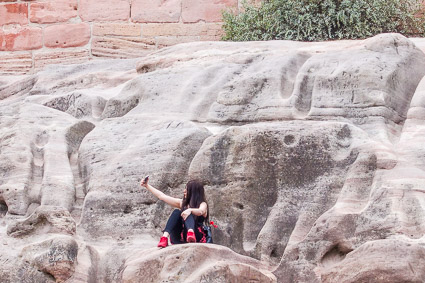
ABOVE: A tourist takes a selfie beneath the walls
of Nuremberg's Imperial Castle.
Nuremberg
is a city of 495,000 people in Franconia, a region of Germany that has been part
of Bavaria since 1803. It's also a busy port for river cruising (see our
Nuremberg Port Guide), both for cruises heading east to the Danube and west
toward the Rhine.
We arrived at Nuremberg Airport and later spent several
days in the city before an Emerald Waterways river cruise
from Nuremberg to Trier via the Main-Danube Canal and the rivers Main, Rhine,
and Moselle. (We also spent time in nearbyErlangen, where Cheryl lived when she was in third and fourth grade.)
-
Tip: If you're
cruising to or from Nuremberg, we strongly recommend that you spend at least
a couple of nights in the city center. There's a lot to see, and the few
sights that aren't within the old city walls are easy to reach by public
transportation.

We arrived at Nuremberg's
Hauptbahnhof (the city's
main railway station), which is easy to reach from the airport by U-Bahn or from
Erlangen, where we'd spent
several nights, by regional train or S-Bahn.

From the station's lower level, we followed the signs for Tourist Information
to the Altstadt, or Old City, where we found the Königstrasse just inside
the city walls.
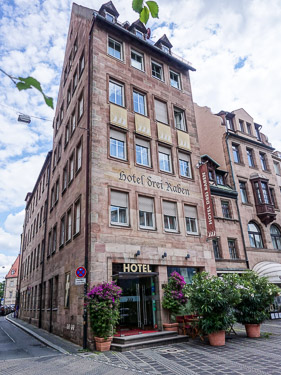
It was only about five minutes (at most) to the
Hotel
Drei Raben, a four-star boutique hotel where we'd made reservations through
our hotel partner, Booking.com.
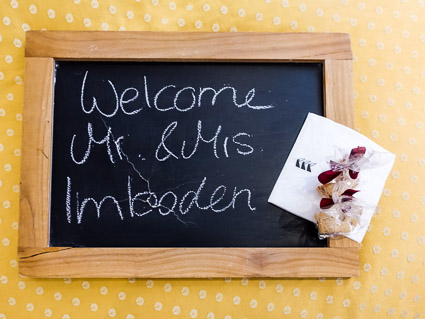
We were welcomed to our room with a message on a blackboard and
cookies in the shape of ravens (Raben).
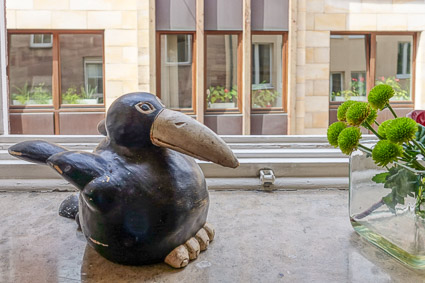
A sculpture on the windowsill featured the hotel's mascot(s).
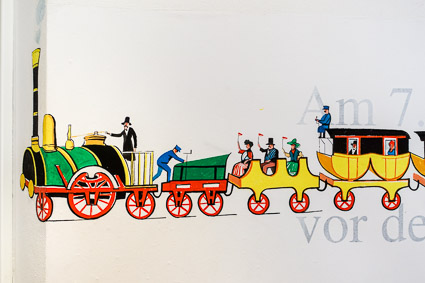
Every room at the Hotel Drei Raben has a different theme.
Our room's wall graphic honored the steam locomotive Adler ("Eagle") and the
Gesellschaft zur Errichtung einer Eisenbahn mit Dampffahrt zwischen Nürnberg und
Fürth,
which was the first railroad in Germany when it opened on December 7, 1835.

From our windows, we could see the Königstrasse and a
traditional-looking building next door.
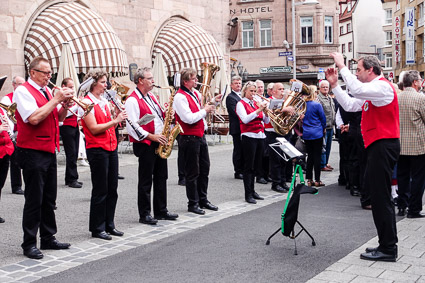
After unpacking, we went for a long walk in Nuremberg's Altstadt, which had changed quite a bit since Cheryl had visited
regularly from her home in Erlangen during the late 1950s.
AA block or two from our hotel, we saw a brass band
performing on a square.
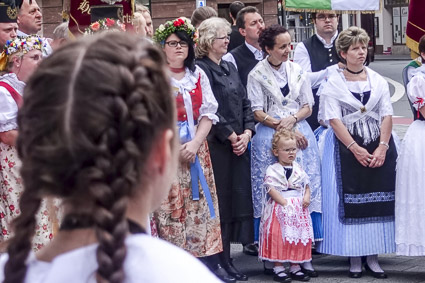
Groups of people in Trachten, or traditional
costume, from towns throughout Franconia stood by as the band played.

When the band had finished, spectactators waited patiently
as local civic and church officials took turns giving speeches.
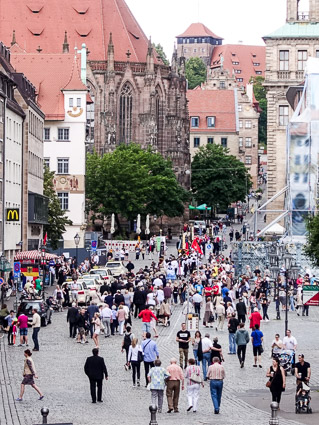
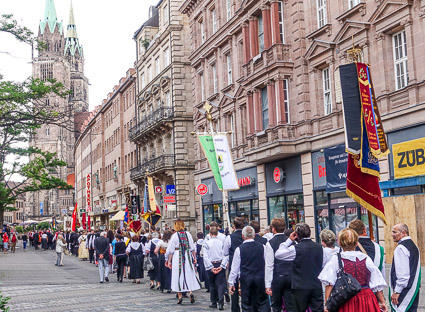
We never did figure out what the event was, but when the
speeches and music were over, the crowd formed a procession and marched toward
the center of the Altstadt.
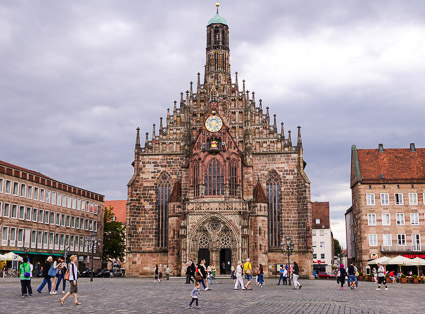
We went on a procession of our own, passing the Hauptmarkt and the Frauenkirche (a.k.a.
Church of Our Lady).
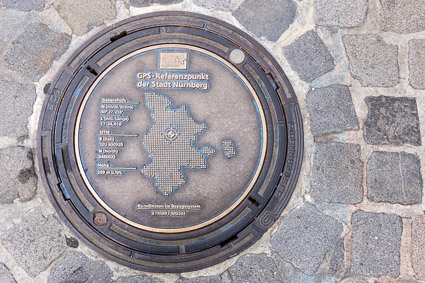
A manhole cover identified our location as the GPS
reference point for the city of Nuremberg.
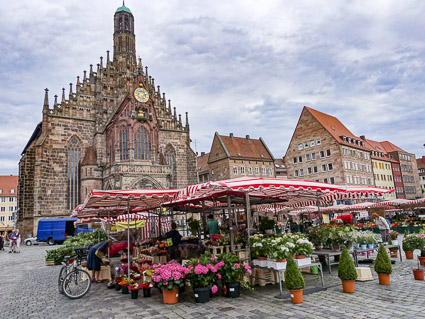

On the Hauptmarkt, vendors were selling produce and other
edibles that ranged from oversize cherries to gluten-free Lebkuchen.
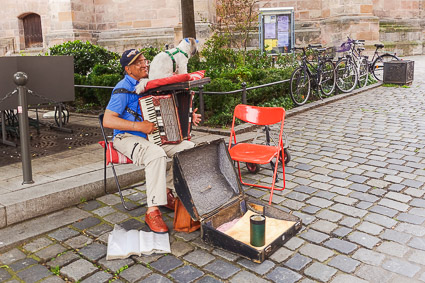
Just up the street, a busker performed on the
Rathausplatz in front of City Hall.
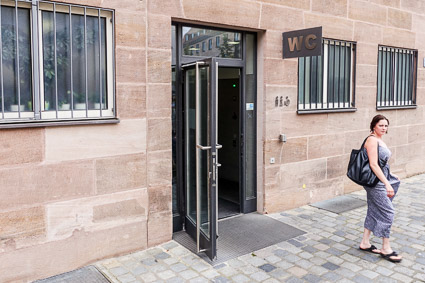
The Rathaus had a typically German concession to practicality: a public
lavatory facing the street, with a modest admission fee of €0,50.

Even though it was a Sunday, many people were
window-shopping in the city center, which had a wide range of shops and
department stores. If we'd been hungry, we could have come back on Monday
to buy custom-formulated Muesli.
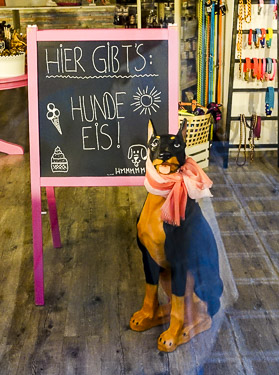
Or, if we'd been from the Internet (where
nobody knows you're a dog), we could have shopped for canine ice cream.

This store sign literally means "Bean and Dress."
Obviously, the owner of the clothing and accessory shop couldn't resist the play
on words.
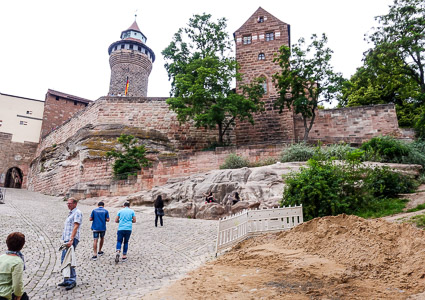
We continued walking until we reached the
Kaiserburg, or Imperial Castle,
at the northern end of the walled Altstadt.
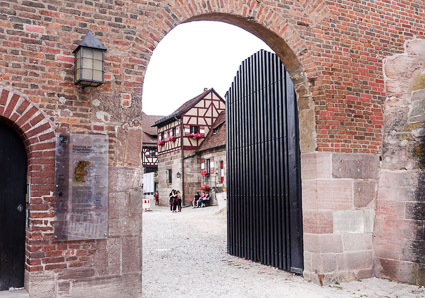
The castle is Nuremberg's premier tourist attraction, and
it's open daily year-round.

We were too jet-lagged to enjoy a museum visit or guided tour,
so we simply went into the Castle Gardens (free admission) to enjoy a panoramic
view of Nuremberg's rooftops.
Click here and maximize your browser window for a larger panoramic image.
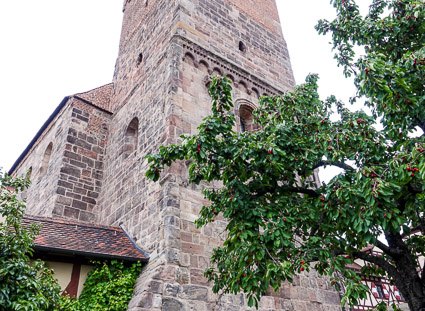
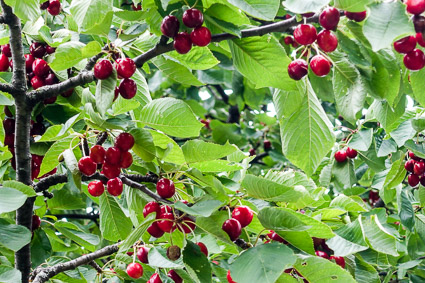
The adjoining
Maria Sibylla Merian Garden was a pleasant walled garden with a lawn,
benches, and a variety of plantings--including this cherry tree, which was heavy
with fruit.
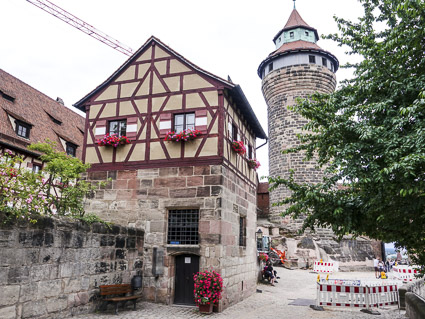
The Well
House and Sinwell Tower are in the castle bailey. Visitors can climb up to a
platform inside the tower for a bird's-eye view of the Altstadt.
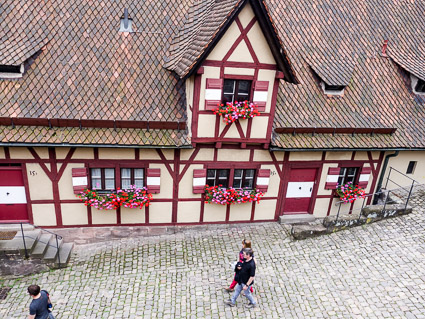
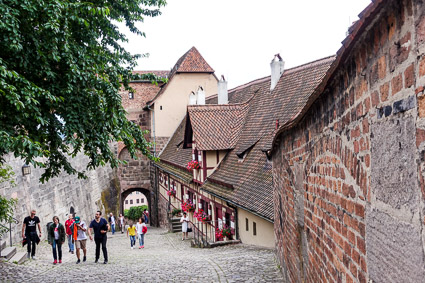
After we'd had our fill of high-altitude Nuremberg, we
walked down the steep cobblestoned path to the exit. (See
castle map.)
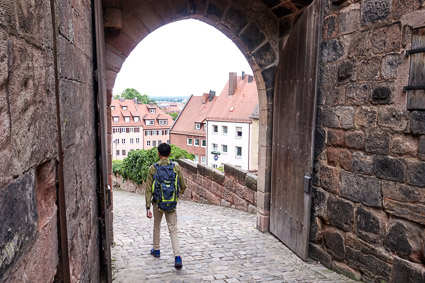
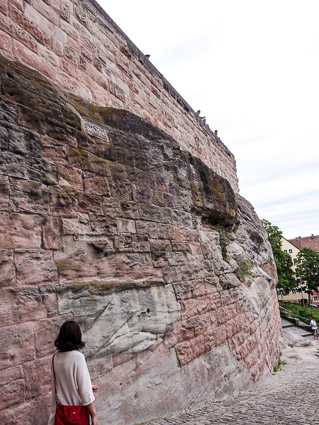
The lower gate led us outside the castle, where we could
see the Kaiserburg&'s massive foundations.
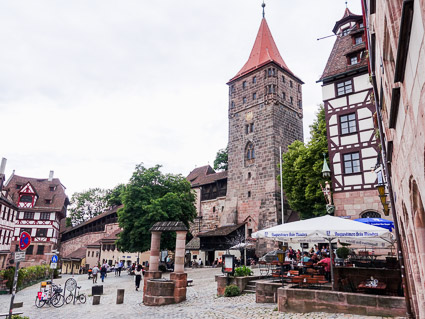
Instead of retracing our route, we bore right as we left
the castle and followed the city's
medieval walls dowhill. We soon reached the Tiergartenplatz.
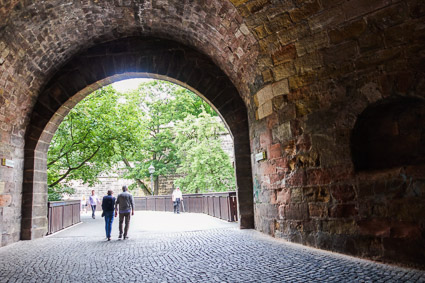
The Tiergartentor, or Zoo
Gate, led to neighborhoods outside the Old City's walls.
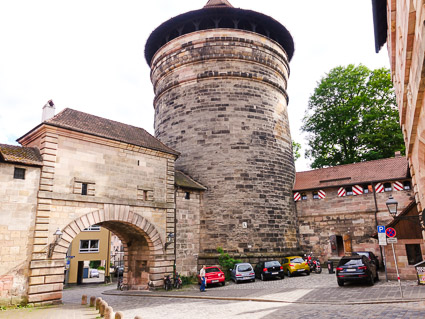
Continuing downhill, we reached the Neutor, or New Gate.
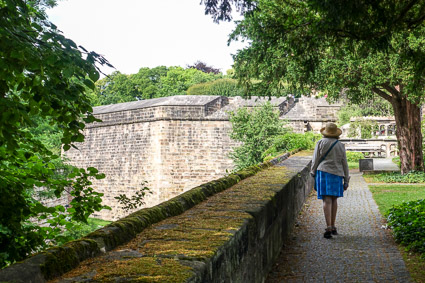
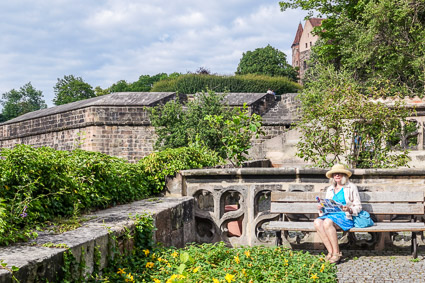
A flight of stone steps took us to a park on top of the
massive walls.

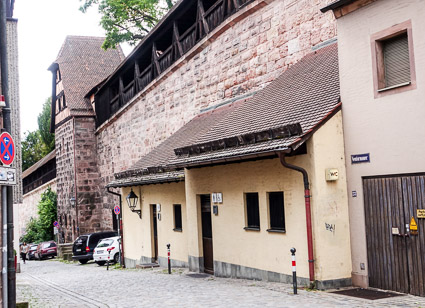
Nuremberg's fortified walls are occupied by apartments,
businesses, and at least one public WC.
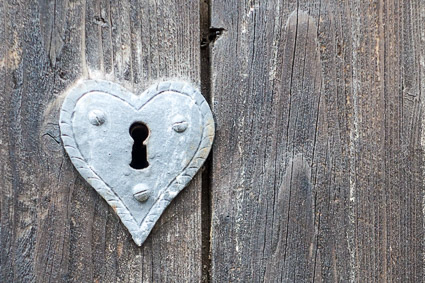
"I ❤ Nuremberg" may be a concept that predates
bumper stickers and t-shirts: We saw this heart-shaped lock on an old wooden
door in the city walls.
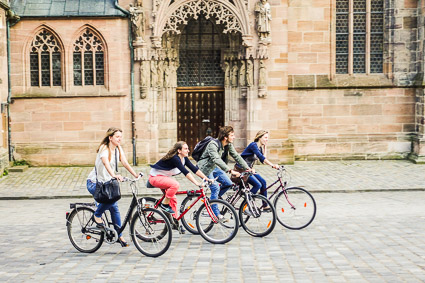
Later, after further explorations of the Altstadt
and a free glass of wine at our hotel, we walked to dinner near the
Sebalduskirche (St. Sebald Church), passing bicyclists along the way.
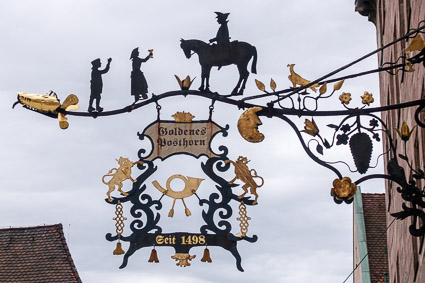
We ate at the
Goldenes
Posthorn, a traditional restaurant with outdoor tables and a menu of
stick-to-your-ribs Franconian food.
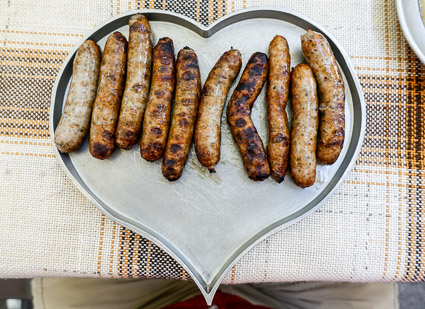
What could have been more appropriate for a romantic dinner in Nürnberg than a
heart-shaped platter of Nürnberger sausages?
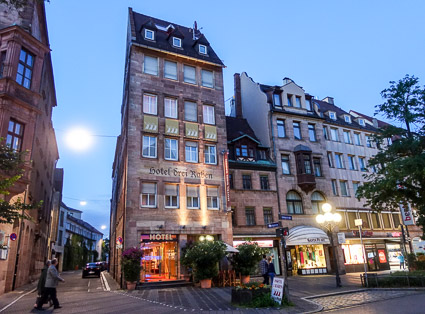
After a long day, we were happy to return to the Hotel Drei
Raben, where a comfortable bed awaited us.
Next day:
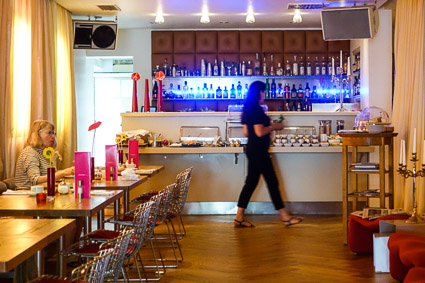
We began our second day in Nuremberg with breakfast at the
Hotel
Drei Raben (included in the "guaranteed lowest available rate" from
Booking.com).
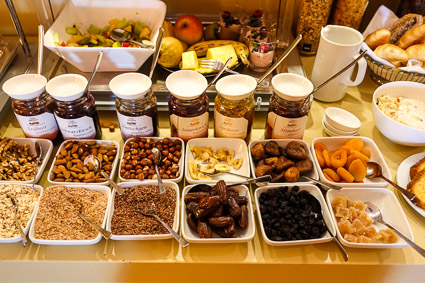
A breakfast buffet had been laid out in the hotel's lobby
bar, where we'd had a free glass of wine the previous evening. (The Hotel Drei
Raben offers its guests a "glass of wine or any other aperitif" with antipasti
from 6 to 8 p.m. daily.)
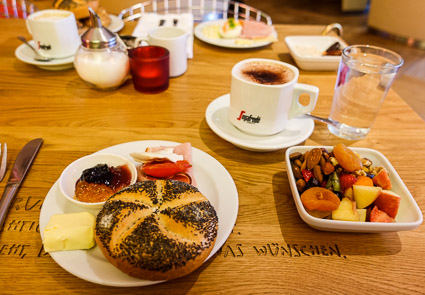
The choice of breads, pastries, fruits, cereals, herring,
meats, cheeses, salads, etc. was competitive with breakfast buffets in five-star luxury hotels.
Sandra, the receptionist
on duty, offered to make eggs, so Cheryl had an omelette with freshly sautéed vegetables.
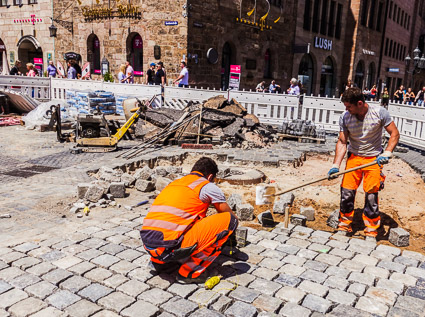
Thanks to our hearty breakfast, we had the strength to
watch municipal workers lay paving stones on a street near our hotel.
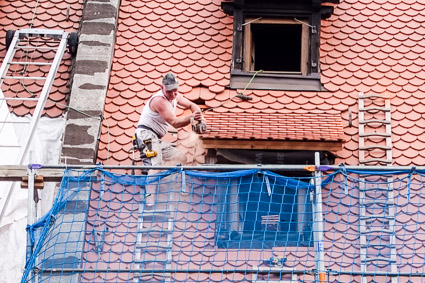
We were happy to be safely on the pavement when we saw a Dachdecker defying gravity on one of Nuremberg's steeply-pitched roofs.
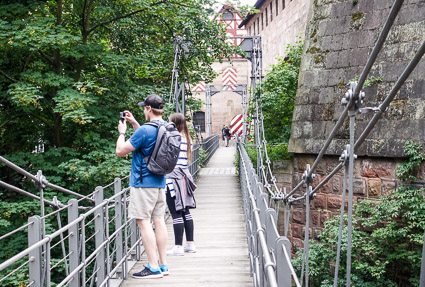
The previous day, as we'd walked along the city walls,
we'd been intrigued by the Kettensteg, a suspension footbridge over the River Pegnitz.
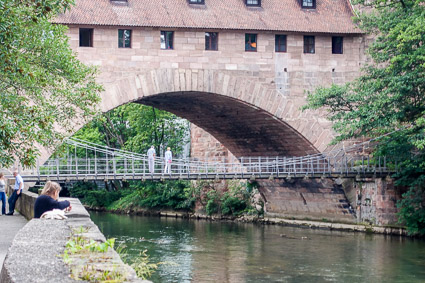
The Kettensteg is older than it looks: Although it
received a major overhaul in 2010, the bridge's key components date back to
1824, and the Kettensteg is said to be the oldest suspension bridge in
Continental Europe.
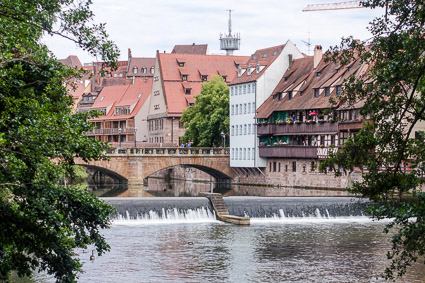
From the Kettensteg, we had a fine view of the River Pegnitz, which runs through Nuremberg's Altstadt. (As the river approaches the city's western walls, a
dam and nearby tunnels control the water flow to prevent flooding.)
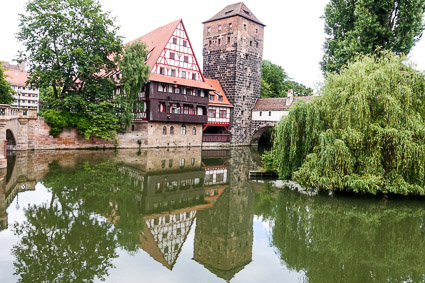
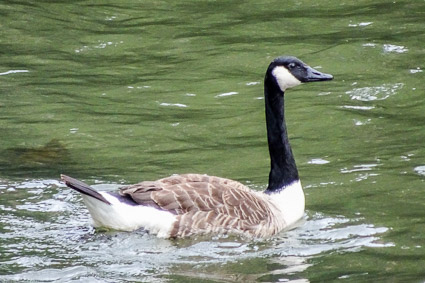
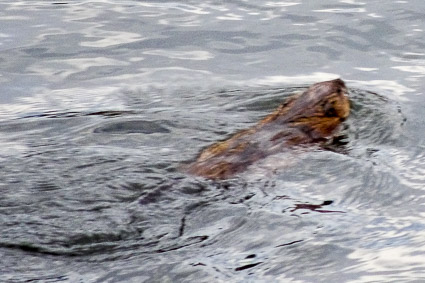
The section of river near the city walls is now a protected nature area. While
walking along the river's banks, we saw geese, ducks, and even a beaver.
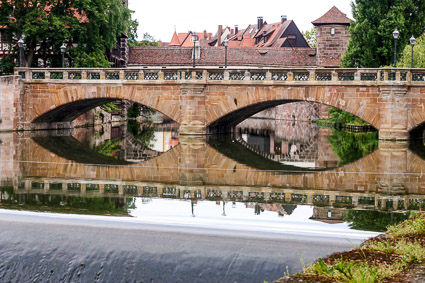
The Maxbrücke, built in 1457, was reflected in
the quiet waters beyond the weir.

The riverside walkway brought us to the
Henkersteg, or Hangman's Bridge, which was built in 1595 and reconstructed
in the 1950s after being destroyed in World War II.

The Henkersteg leads to a tiny island in the river, the
Trödelmarktinsel,
which is home to small independently-owned shops and a few restaurants. (In
prior centuries, the island was known for its pig market and flea market.)
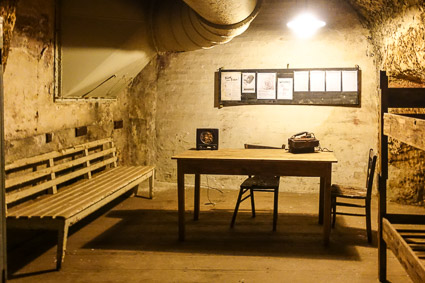
In the afternoon, we took a tour of the
Historische Kunstbunker or Historic Art
Bunker in the Castle Hill, where the city stored its
most precious works of art in World War II.
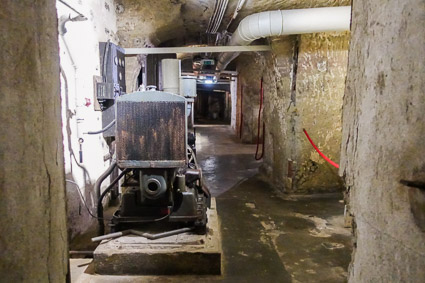
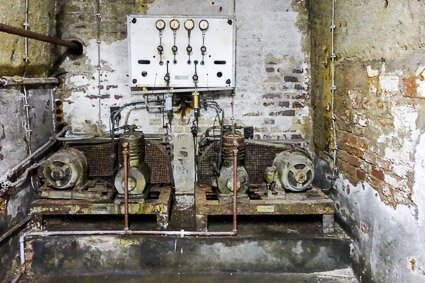
The bunkers, in old beer cellars carved from bedrock under
the Imperial Castle, were fitted with air conditioning and pumps to preserve the
paintings, statues, historic treasures, and other irreplaceable objects.
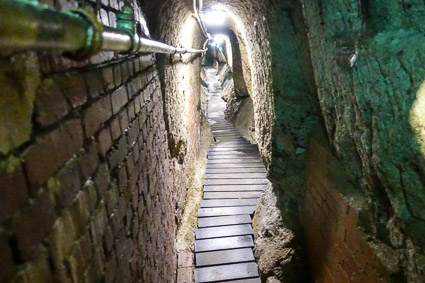
Tunnels connect the Historic Art Bunkers with other areas
of the Imperial Castle's Historic Rock-Cut Cellars, which were used as civilian bomb shelters in
World War II.

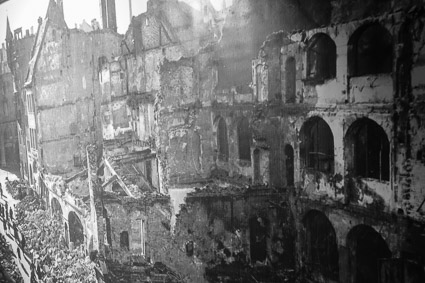
At the end of our tour, we saw photos, unexploded bombs,
and a video that showed the devastation of Nuremberg by Allied bombings and the
city's postwar reconstruction.

Nuremberg's Altstadt still has construction sites.
(Although it follows the old medieval plan, the Old City continues to evolve.)

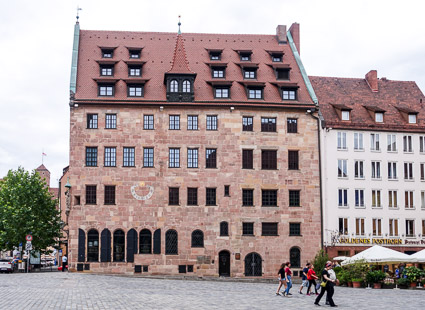
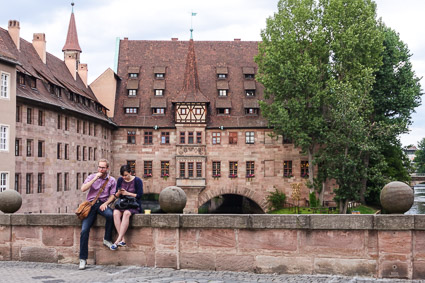
Steeply pitched tile roofs with dormers are characteristic
elements of Nuremberg's architecture, and even newer structures must fit in with
restored pre-war buildings like these.

Still, it must be said that modern Nuremberg isn't without
international influences.
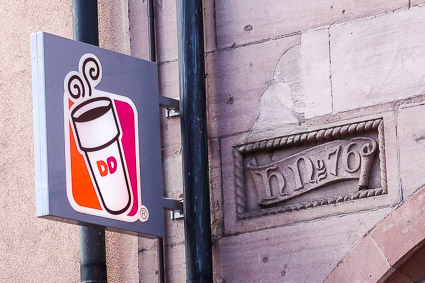
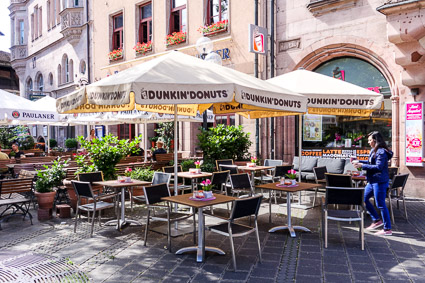
Durant was especially taken with the
Dunkin' Donuts at Königstrasse
76, which was a tasteful combination of rectilinear architecture and circular
cuisine.
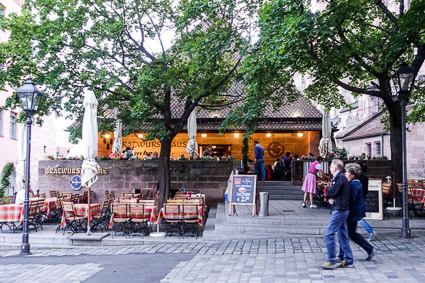
Tempting though Dunkin's Krapfen might have been, we saved our appetites
for dinner--this time at the
Bratwursthäusle on the Rathausplatz, a local institution that our hotel receptionist had said we shouldn't miss.

Another day, another platter of Nürnburger sausages
(best enjoyed with the Bratwursthäusle's delicate Weinsauerkraut.)
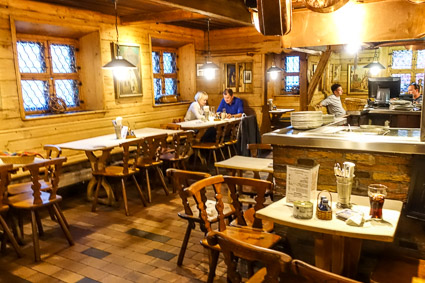
After eating outdoors on the terrace, we checked out the
restaurant's cozy interior, which we'll have to try the next time we're in
Nuremberg on a cool or rainy day.
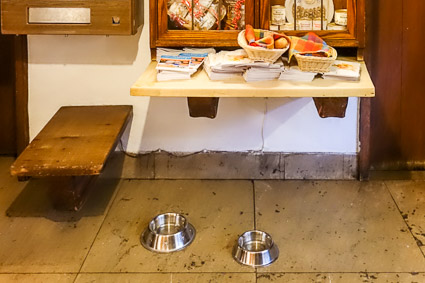
Q: How can you tell
that a German restaurant caters to locals, and not just to foreign tourists?
A: By the water bowls
for dogs.
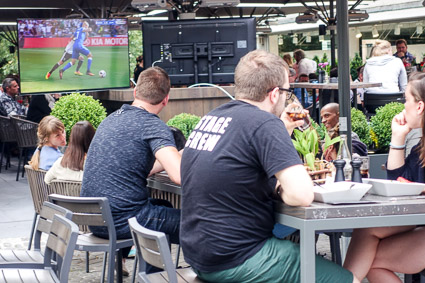
For our evening walk, we headed toward the eastern half of
the Altstadt, passing a bar-restaurant where football fans were watching France
defeat Iceland in the UEFA Euro championships.
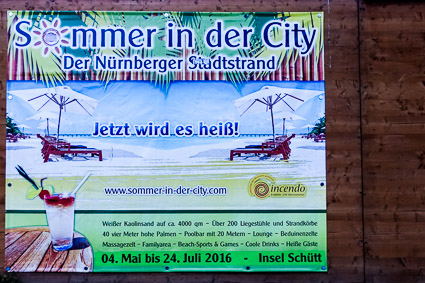
Our walk led us to an island in the Pegnitz, the Insel
Schütt, where an event called
Sommer in der City was running from early May through late July.

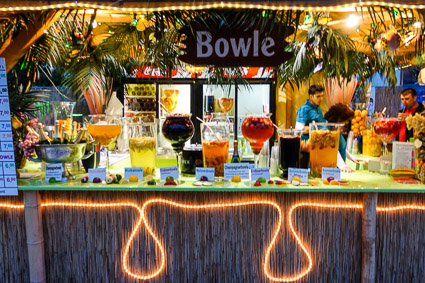
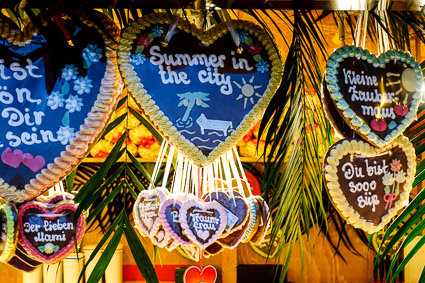
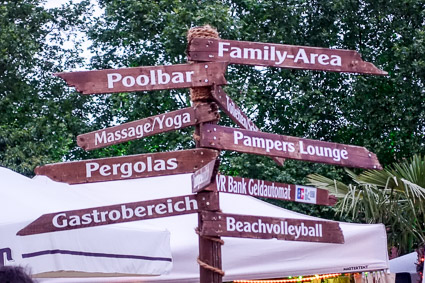

The "Nuremberg City Beach" had sand, a boardwalk with
chairs for sunbathing, bars serving tropical drinks, food stalls, activities for
children, a beach volleyball court, and even a riverside outpost of Dunkin'
Donuts.
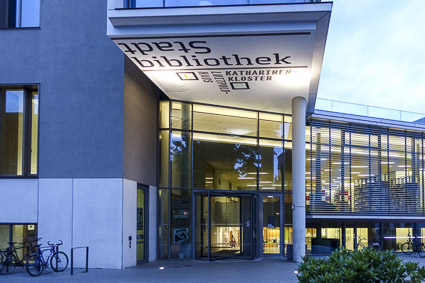
Leaving the island, we passed
Cinecittà, Germany's largest cinema complex,
and the Stadtbibliothek
or Public Libary
as we walked south toward the main railroad station.
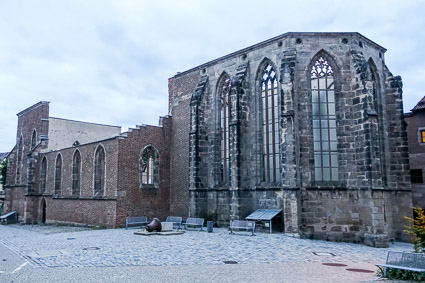
A couple of minutes later, we reached the Lutheran
Katherinenkirche (in
English, St. Catherine's Church),
which was largely destroyed by World War II bombing.

The church has been stabilized and preserved as a ruin.
Under the name "St. Katherina Open Air," it offers music concerts and theatre
performances every summer.
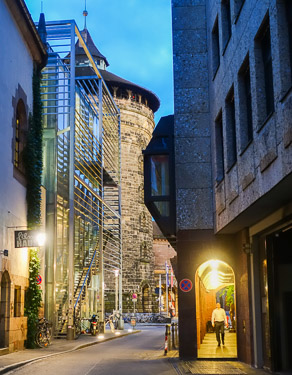
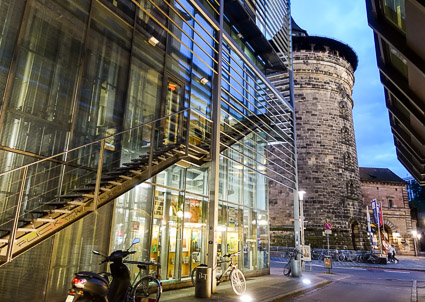
We wrapped up our evening walk by admiring the glass-walled
Nuremberg
Tourist Information Office at Königstrasse 93, which faces the railroad
station and the Königstor city gate.
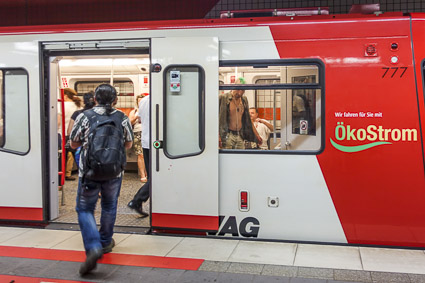
The next morning, we walked from the Hotel Drei Raben to the
Nuremberg Hauptbahnhof,
where we caught a U-Bahn
train (Line 2) to the airport for our free transfer to
Emerald Star in the
Nuremberg Cruise Port.